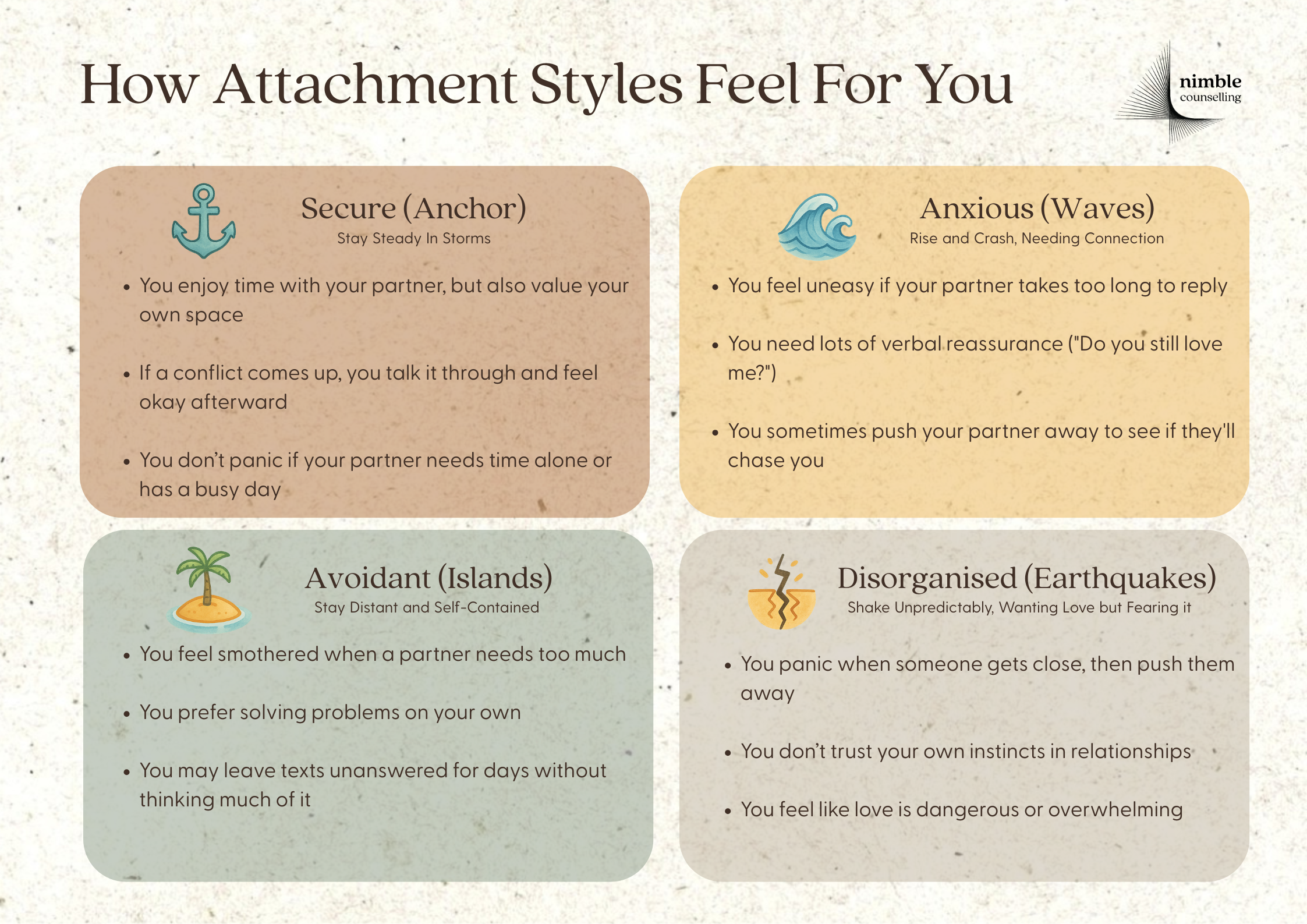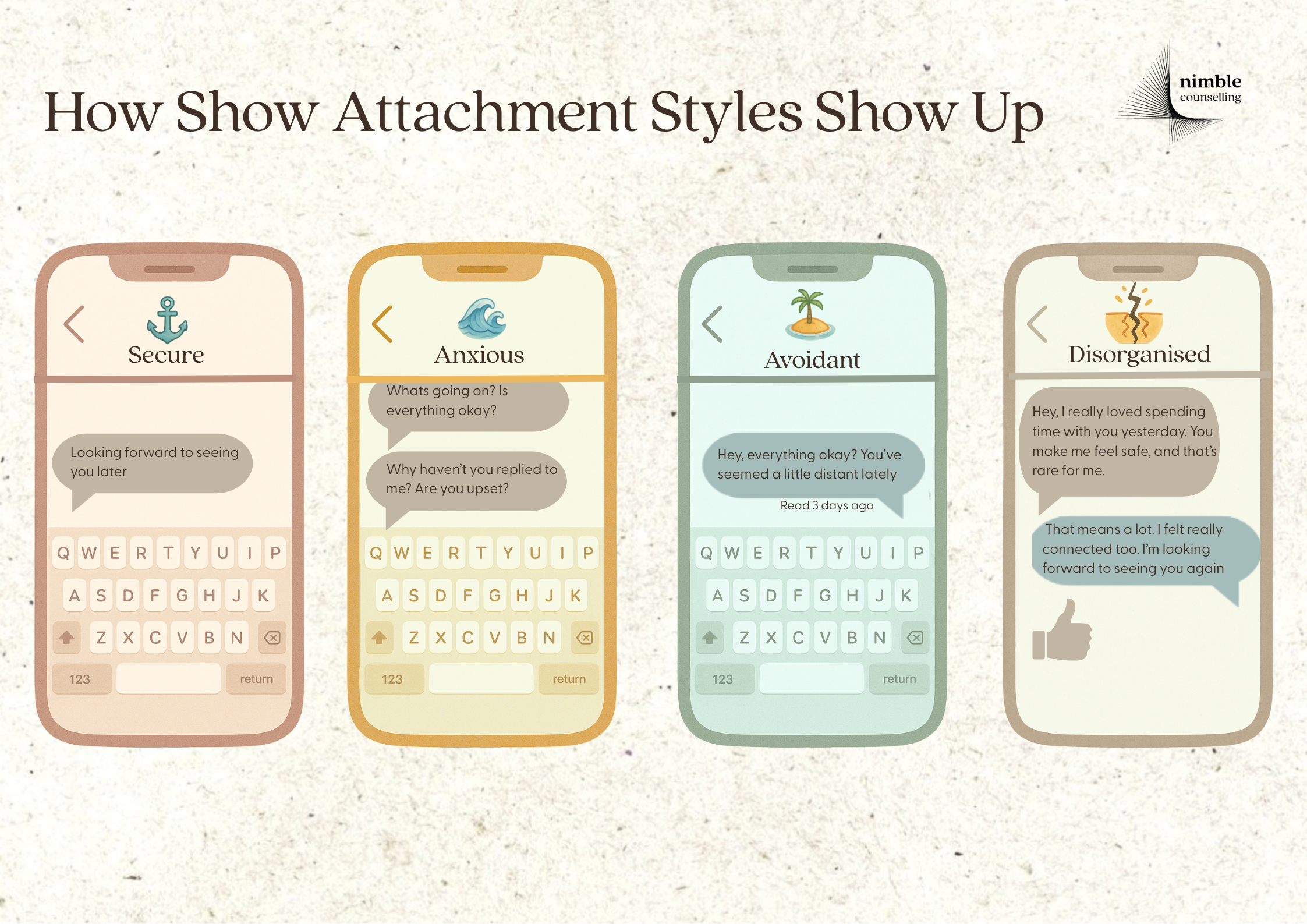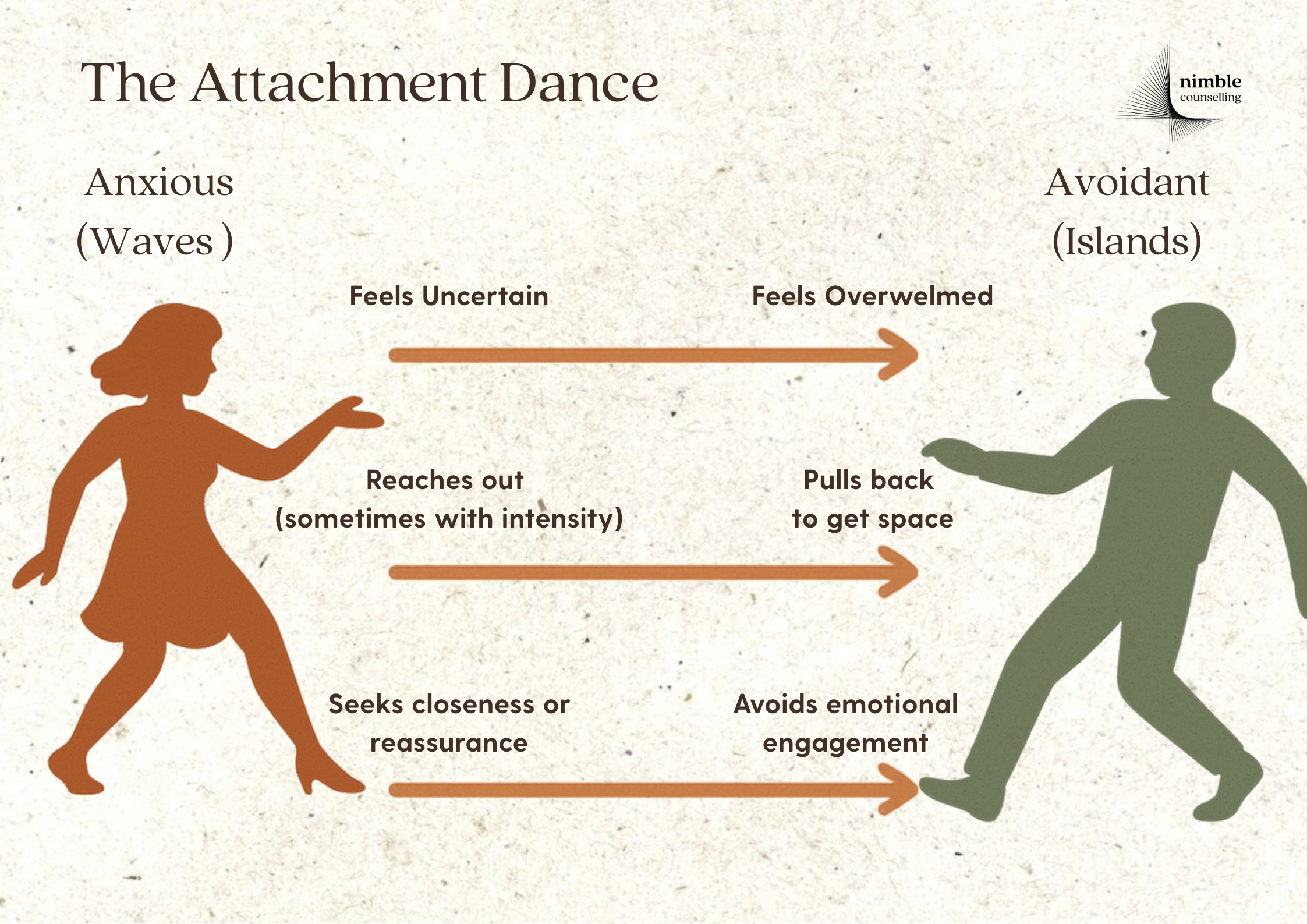What’s Your Attachment Style? Understanding How You Connect in Relationships
Nimble Counselling founder Anna MacGillivray walks us through attachment styles what they are, why they matter, and how you can begin to recognize their patterns in yourself and those around you.
What Is Attachment, and Why Does It Matter?
Have you ever noticed how some people seem calm and secure in relationships, while others might worry a lot or pull away when things get too close? These patterns are often linked to something called your attachment style.
Your attachment style is the way you naturally relate to others, especially in close relationships. It shapes how you give and receive love, how you handle conflict, and how secure you feel with emotional intimacy. Understanding your attachment style can help you:
Build stronger, healthier relationships
Communicate more effectively
Heal past wounds
Make sense of emotional reactions
Attachment theory originally came from research on babies and their caregivers, but it now helps explain how adults connect in love, friendship, and even therapy. The idea is simple: as humans, we’re wired to seek connection. But based on our early experiences, we may have learned different ways to get those needs met.
What Are the Four Main Attachment Styles?
There are four primary adult attachment styles:
Secure Attachment
Anxious (Preoccupied) Attachment
Avoidant (Dismissive) Attachment
Disorganized (Fearful-Avoidant) Attachment
Let’s explore what each one looks like.
What Does a Secure Attachment Style Look Like?
People with a secure attachment style generally:
Feel comfortable with both closeness and independence
Trust that others will be there for them
Can express their needs directly
Navigate conflict without excessive anxiety or withdrawal
They’re able to form strong emotional bonds without losing themselves. In relationships, they tend to be supportive, warm, and responsive.
Examples:
You enjoy time with your partner, but also value your own space
If a conflict comes up, you talk it through and feel okay afterward
You don’t panic if your partner needs time alone or has a busy day
What Does an Anxious Attachment Style Look Like?
People with an anxious attachment style often:
Crave closeness but worry their partner will leave
Feel insecure if they don’t get enough reassurance
Get easily upset if they feel ignored or rejected
Try to reconnect through “protest behaviours” (like withdrawing, texting repeatedly, or acting out)
They may feel like they are “too much” in relationships, loving deeply but constantly fearing abandonment.
Examples:
You feel uneasy if your partner takes too long to reply
You need lots of verbal reassurance ("Do you still love me?")
You sometimes push your partner away to see if they'll chase you
What Does an Avoidant Attachment Style Look Like?
People with an avoidant attachment style often:
Value independence over closeness
Feel uncomfortable with too much emotional intimacy
Downplay their own and others’ emotional needs
Withdraw or shut down during conflict
Avoidantly attached people learned to rely on themselves and keep others at arm’s length to feel safe.
Examples:
You feel smothered when a partner needs too much
You prefer solving problems on your own
You may leave texts unanswered for days without thinking much of it
What Does a Disorganized Attachment Style Look Like?
People with a disorganized (fearful-avoidant) style tend to:
Crave love but also fear it
Feel unsafe even in good relationships
Swing between clinging and pushing others away
React with intense emotions or dissociation
Disorganized attachment often develops when early relationships involved trauma, neglect, or chaos.
Examples:
You panic when someone gets close, then push them away
You don’t trust your own instincts in relationships
You feel like love is dangerous or overwhelming
How Do Attachment Styles Show Up in Daily Life?
Your attachment style can influence:
Texting:
Secure: "Looking forward to seeing you later."
Anxious: "Why haven’t you replied yet? Are you upset with me?"
Avoidant: Leaves messages unread for hours or days.
Disorganized: Sends mixed messages, unsure whether to connect or cut off
Conflict:
Secure: Talks things through calmly
Anxious: Gets upset quickly, seeks immediate reassurance
Avoidant: Shuts down, gets quiet or leaves
Disorganized: May react with panic or anger, then disappear
Asking for Needs:
Secure: "I’d love to spend more time together."
Anxious: "Do you even want to see me anymore?"
Avoidant: Avoids asking altogether, expects others to guess
Disorganized: Fluctuates between over-explaining and avoidance
Is There a Simple Way to Understand These Styles?
Here’s a metaphor we love from therapist Stan Tatkin that helps us understand:
Stan Tatkins attachment style metaphor can help us frame how we connect in relationships in a more concrete way.
🌱 Anchors (Secure) stay steady in storms.
🌊 Waves (Anxious) rise and crash, needing connection.
🏝️ Islands (Avoidant) stay distant and self-contained.
⛰️ Earthquakes (Disorganized) shake unpredictably, wanting love but fearing it.
This imagery helps people recognize themselves (and their partners) in a compassionate, non-blaming way.
What Is the "Attachment Dance?"
In relationships, these styles often interact in predictable patterns. One of the most common is the pursuer-distancer cycle, also known as the attachment dance.
Knowing our role in the attachment dance can help us break free.
Here’s how it might go:
Anxious Partner (the Wave):
Feels uncertain
Reaches out (sometimes with intensity)
Seeks closeness or reassurance
Avoidant Partner (the Island):
Feels overwhelmed
Pulls back to get space
Avoids emotional engagement
This triggers the anxious partner’s fears even more—they reach out again, which pushes the avoidant partner further away.
It’s a frustrating cycle, but not a hopeless one. Once you recognize the pattern, you can start learning new steps together.
Can Attachment Styles Change?
Yes, they can! Although our styles are shaped early in life, they are not set in stone. With awareness, support, and new experiences, you can develop what's called earned secure attachment.
That might mean:
Learning to self-soothe when anxious thoughts arise
Practicing vulnerability and emotional presence if you tend to withdraw
Exploring past attachment wounds in therapy
Communicating your needs with honesty and kindness
Therapy is a powerful tool for this, especially when the relationship with your therapist becomes a model for what safe, responsive connection can look and feel like.
How Can I Start Healing My Attachment Style?
Begin with curiosity. Ask yourself:
What patterns do I notice in how I relate to others?
What feels hardest about closeness?
How do I react when I feel disconnected?
What are my earliest memories of feeling safe or unsafe with others?
You might explore these questions in therapy or journaling. From there, work on:
Self-awareness: Track your attachment triggers (e.g., no response to a text, partner needing space).
Self-compassion: Your attachment style is not a flaw. It's an adaptation that once helped you survive.
New behaviours: Try expressing needs clearly, taking space kindly, or offering comfort instead of criticism.
Co-regulation: Learn how to soothe and be soothed by others. This is part of healthy connection.
What Does Secure Attachment Feel Like?
A secure relationship isn’t perfect, but it feels safe. You can:
Express your needs without fear
Apologize and forgive
Argue without fearing it will end everything
Spend time apart without anxiety
Be yourself and let your partner be themselves
Security is built over time, in small moments: a warm look, a steady presence, a kind word. With enough of those moments, even deeply ingrained patterns can shift.
What If My Partner and I Have Different Styles?
That’s very common! What matters is how you both respond to each other’s needs and whether you're willing to grow.
If you're an anxious partner:
Practice slowing down and checking your stories before reacting
Share your feelings without blaming
Learn self-soothing tools
If you're an avoidant partner:
Make small gestures of connection
Share what you're feeling, even if it's brief
Reassure your partner that you're there
Working with a couples therapist trained in attachment can help both of you learn the steps of a new dance.
Where Can I Learn More?
Some great resources include:
Attached by Amir Levine & Rachel Heller
Wired for Love by Stan Tatkin
Hold Me Tight by Sue Johnson
Therapy with an attachment-informed counsellor
There are also helpful quizzes and workbooks online that can give you a starting point for understanding your style.
Final Thoughts: What If You Could Feel More Secure?
Imagine feeling calm in your relationships. Imagine being able to say, "I need this" without fear. Imagine trusting that you're lovable as you are.
That’s what healing your attachment system can offer. It’s not about being perfect or never getting triggered again. It’s about learning how to come back to connection—with yourself and others.
No matter where you start, secure attachment is a path you can choose.
If you're looking for a place to begin, our team at Nimble Counselling offers compassionate, attachment-informed support for individuals and couples. We’d be honoured to help you explore your style and build stronger, safer connections.
Client Resources to Explore Attachment Further
The Attachment Project: Free attachment style quiz, articles, and online courses.
The Secure Relationship Podcast by Julie Menanno: A therapist-led podcast on secure relating.
Your Brain on Love by Stan Tatkin (Audio Program): Attachment science meets neuroscience for couples.
Book: Attached – The New Science of Adult Attachment by Dr. Amir Levine & Rachel Heller (2010).
A reader-friendly introduction to adult attachment styles (secure, anxious, avoidant) and their impact on romantic relationships.Book: Wired for Love by Dr. Stan Tatkin (2012).
Focuses on how our brains and attachment styles affect relationship dynamics.
Exploring your attachment style is a powerful step toward healthier relationships and deeper self-understanding. At Nimble Counselling, we specialize in attachment-based therapy and relationship counselling for individuals and couples. Our experienced team offers in-person counselling at our downtown Vancouver clinic and secure online therapy across British Columbia. Whether you're seeking support for anxiety, communication challenges, or relationship patterns, we're here to help you build more secure, connected ways of relating. Book a session today and discover how therapy can support lasting emotional growth.







